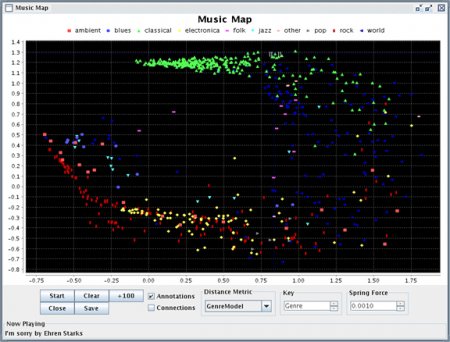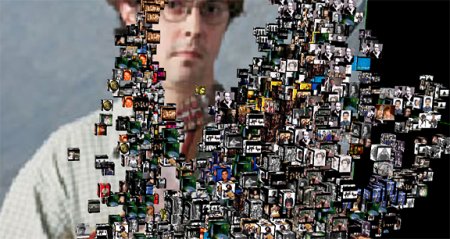Sun has learned to analyze musical rhythms
To search for similar music, a whole set of Internet services has already been created. These are special algorithms that show the “generic” proximity of musical performers to each other ( Musicplasma , Pandora or MusicIP ), and social networks that calculate which music you like by analyzing the musical preferences of people with the same tastes ( Last.fm ) . However, none of these tools can be called perfect. The problem is that they sort the music by recommendations or by external attributes (the name of a group, a song, a musical genre), but not by an internal essence .
In this sense, a revolutionary research project called Search Inside The Music , developed in Sun Labs laboratories. With this technology, you can classify large music collections, as well as find songs that are similar to each other. The system not only performs acoustic analysis, but can also take into account social information, that is, the preferences of various users, to make recommendations.
Acoustic analysis of each song is a breakdown of the track into frames of 40 milliseconds and the selection of metadata from each frame. Metadata is expressed in numerical terms: pitch, consonance, tonality, timbre, instrumentation, rhythm patterns, and also energy level, that is, intensity. When a large database is compiled with the exact characteristics of each song, you can visualize this data as 2D or 3D. For example, on a two-dimensional map from below you can see how different genres of music differ in their acoustic characteristics. Classical music is marked green, blue is ethnic (circles) and blues (triangles), ambient and rock is red, electronic is yellow, gray is pop, and purple is folk.

')
If you take into account more than two parameters, you can place the music tracks in three-dimensional space.

In addition to the analysis using algorithms, the system supports the recommendations engine, that is, it is able to take into account the opinion of people to search for “similar” compositions. But such systems have a major drawback - they “push” up only popular music, while little-known performers (and music from previous years) have practically no chance of popularity. As long as some mod doesn’t cover a whole layer of users, the social recommendation system will not notice this.
Unlike "pure" systems of recommendations, the development of Sun Labs instantly calculates high-quality music, regardless of how popular it is and how old it is.
During the experiment, the system was launched on a sample of 5000 musical compositions, after which the results were sorted in three-dimensional form, where a photo of the performer was placed on each “cube”. It looks very impressive.

The only problem of the system from Sun Labs is extreme demands on computing resources. An ordinary home PC needs six years to analyze a collection of 2 million songs. Even a distributed computer network of hundreds of machines hardly copes with the analysis of such a volume of data (1000 machines do it in two days), and then you need to store information about every 40-ms frame somewhere. Therefore, with the implementation of the program for personal computers will have to wait a bit.
However, the new development has a huge commercial potential. The system can be used for analysis, comparison, recommendations, besides it is capable of much more. Say to make playlists with smoothly changing characteristics of music. For example, a two-hour playlist in which the intensity of the music gradually decreases from very high to very low. Surely, this technique acts hypnotizing and lull anyone.
But the most interesting thing will begin when the musicians themselves start using this program to compose new music - perhaps one that humanity has never heard before.
In this sense, a revolutionary research project called Search Inside The Music , developed in Sun Labs laboratories. With this technology, you can classify large music collections, as well as find songs that are similar to each other. The system not only performs acoustic analysis, but can also take into account social information, that is, the preferences of various users, to make recommendations.
Acoustic analysis of each song is a breakdown of the track into frames of 40 milliseconds and the selection of metadata from each frame. Metadata is expressed in numerical terms: pitch, consonance, tonality, timbre, instrumentation, rhythm patterns, and also energy level, that is, intensity. When a large database is compiled with the exact characteristics of each song, you can visualize this data as 2D or 3D. For example, on a two-dimensional map from below you can see how different genres of music differ in their acoustic characteristics. Classical music is marked green, blue is ethnic (circles) and blues (triangles), ambient and rock is red, electronic is yellow, gray is pop, and purple is folk.

')
If you take into account more than two parameters, you can place the music tracks in three-dimensional space.

In addition to the analysis using algorithms, the system supports the recommendations engine, that is, it is able to take into account the opinion of people to search for “similar” compositions. But such systems have a major drawback - they “push” up only popular music, while little-known performers (and music from previous years) have practically no chance of popularity. As long as some mod doesn’t cover a whole layer of users, the social recommendation system will not notice this.
Unlike "pure" systems of recommendations, the development of Sun Labs instantly calculates high-quality music, regardless of how popular it is and how old it is.
During the experiment, the system was launched on a sample of 5000 musical compositions, after which the results were sorted in three-dimensional form, where a photo of the performer was placed on each “cube”. It looks very impressive.

The only problem of the system from Sun Labs is extreme demands on computing resources. An ordinary home PC needs six years to analyze a collection of 2 million songs. Even a distributed computer network of hundreds of machines hardly copes with the analysis of such a volume of data (1000 machines do it in two days), and then you need to store information about every 40-ms frame somewhere. Therefore, with the implementation of the program for personal computers will have to wait a bit.
However, the new development has a huge commercial potential. The system can be used for analysis, comparison, recommendations, besides it is capable of much more. Say to make playlists with smoothly changing characteristics of music. For example, a two-hour playlist in which the intensity of the music gradually decreases from very high to very low. Surely, this technique acts hypnotizing and lull anyone.
But the most interesting thing will begin when the musicians themselves start using this program to compose new music - perhaps one that humanity has never heard before.
Source: https://habr.com/ru/post/5006/
All Articles